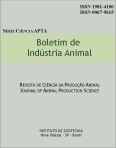Relationships among chemical compositions of 9-10-11th ribs, carcass and empty body of young Nellore bulls
Keywords:
beef cattle, body composition, indirect determination, feedlotAbstract
The direct determination of carcass and empty body composition as experimental routine, despite being the most accurate method, is time consuming, laborious and expensive. Therefore, indirect methods have been developed to estimate on quick, simple, economical and reliable ways for the compositions of carcass and empty body of beef cattle. This study aimed to obtain the correlations among the compositions of 9-10-11th ribs, carcass and empty body for protein, fat, ashes and water contents, expressed in percentage and kilograms, in young Nellore bulls. Sixty-seven non-castrated Nellore bulls were randomly selected for confining period in two consecutive years (2008 and 2009) and were confined in individual pens for approximately 100 days, until they reached a subcutaneous fat thickness of 4 mm over the Longissimus muscle. They were slaughtered at an average age of 540 days and body weight of 398 kg. Chemical analysis of the 9-10-11th ribs, carcass and empty body were carried for protein, fat, ashes and water. The 9-10-11th ribs cut was obtained according to Hankins and Howe (1946). Carcass composition was obtained after grinding, homogenizing, sampling, analyzing and combining edible portions and bones. Empty body composition was obtained after grinding, homogenizing, sampling, analyzing, and combining blood, hide, head + feet, viscera, and carcass. The correlation coefficients were calculated between ribs and carcass, and between ribs and empty body for the contents expressed in percentage and kilograms. The correlations obtained between composition of 9-10-11th ribs and carcass were 0.68; 0.62; 0.05; and 0.79, respectively, for percentages of protein, fat, ashes and water. For the same tissues, expressed in kilograms, the correlations obtained were 0.66; 0.73; 0.49; and 0.79, respectively, for contents of protein, fat, ashes and water. For the relationships between composition of the 9-10-11th ribs and empty body, the correlation coefficients found were 0.77; 0.64; 0.13; and 0.64, respectively, for percentages of protein, fat, ashes and water. In addition, the correlations obtained for the same tissues, expressed in kilograms, were 0.59, 0.71, 0.48 and 0.77, respectively, for contents of protein, fat, ashes and water. The correlation coefficients found for protein, fat and water between ribs and carcass and between ribs and empty body were positive and high, indicating a good association among these traits. For ashes, the correlation coefficients detected were medium to low, being better when the contents were expressed in kilograms. Highly significant correlation coefficients, above 0.70, were detected between ribs and carcass fat and water, and ribs and empty body fat and water, expressed in kilograms. The use of the 9-10-11th ribs composition for estimating the carcass and empty body compositions is effective, allowing an accurate estimation mainly for fat and water contents.Downloads
Downloads
Published
Issue
Section
License
Os autores não serão remunerados pela publicação de trabalhos, pois devem abrir mão de seus direitos autorais em favor deste periódico. Por outro lado, os autores ficam autorizados a publicar seus artigos, simultaneamente, em repositórios da instituição de sua origem, desde que citada a fonte da publicação original seja Boletim de Indústria Animal. A revista se reserva o direito de efetuar, nos originais, alterações de ordem normativa, ortográfica e gramatical, com vistas a manter o padrão culto da língua e a credibilidade do veículo. Respeitará, no entanto, o estilo de escrever dos autores. Alterações, correções ou sugestões de ordem conceitual serão encaminhadas aos autores, quando necessário. Nesses casos, os artigos, depois de adequados, deverão ser submetidos a nova apreciação. As opiniões emitidas pelos autores dos artigos são de sua exclusiva responsabilidade. Todo o conteúdo deste periódico, exceto onde está identificado, está licenciado sob a Licença Creative Commons Attribution (CC-BY-NC). A condição BY implica que os licenciados podem copiar, distribuir, exibir e executar a obra e fazer trabalhos derivados com base em que só se dão o autor ou licenciante os créditos na forma especificada por estes. A cláusula NC significa que os licenciados podem copiar, distribuir, exibir e executar a obra e fazer trabalhos derivados com base apenas para fins não comerciais.













